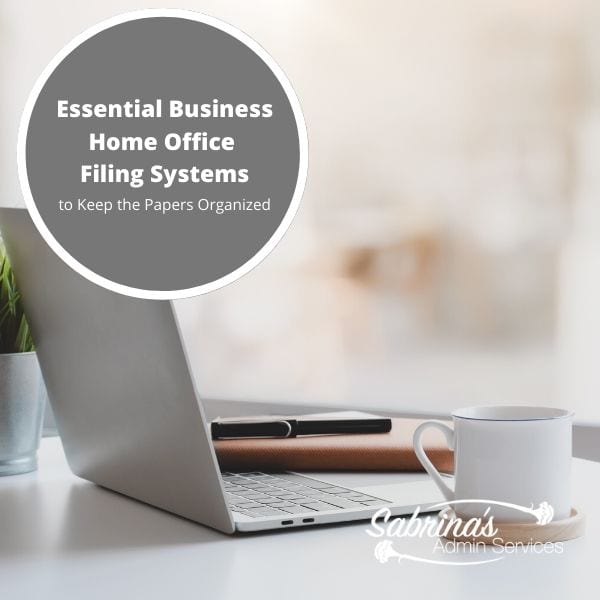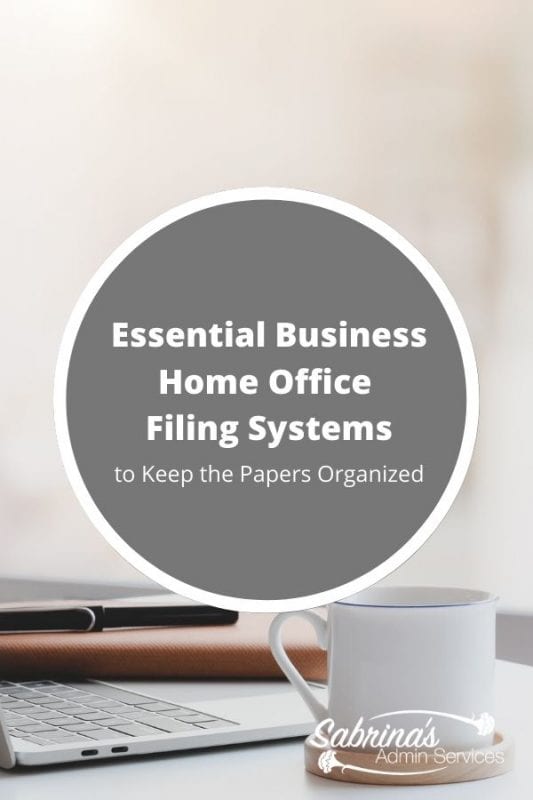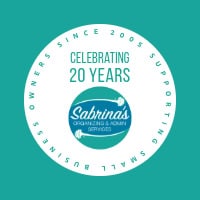Do you work from home most of the time? If so, you probably have papers that need to be filed. Whether they are long-term storage or short-term task papers, you will need places to store these things to be able to retrieve them easily. In this post, we discuss the essential business home office filing systems you need to make your office work more efficiently.
Let’s start with the temporary papers in your office.
Table of contents
Temporary Home Office Filing System
These temporary filing systems are papers that need to be looked at and used right away. It doesn’t need a permanent spot. Some examples of places to store these papers are:
- “In bin” on the desk (affiliate).
- Bills go through and pay area.
Bins to use for these could be open, closed, stacked, or mounted to the wall. Pick whichever one works for your home office. Below are some I found on Amazon (affiliate). If you click through and buy, I will receive a small commission at no additional cost to you.
 Buy Now →
Buy Now →  Buy Now →
Buy Now → (affiliate)
Now, let’s look at the paper files that are readily looked at and used almost every day.
Active Home Office Filing System
These active home office filing systems are usually near your desk (affiliate) in a side drawer that is easily accessible. Items included in this area are:
- Stamps, envelopes, and return address labels
- Paper for the current year.
- Reference information.
- Checkbooks and other account information.
- Current files you may need to reference.
- Paperwork you need to reference yearly.
- Projects you are currently working on.
This filing cabinet (affiliate) should have a lock so that no one can get in there. Place the extra key in a safe place and let someone close to you know where you stored it.
Below are some examples of what the active home office filing system looks like. I found these on Amazon (affiliate).

Drawer File Cabinet (3) for Home Office
Buy Now →
Fireproof Document File Organizer Box with lock
Buy Now →(affiliate)
Let’s look at the next area, which is the long-term home office files.
Long-Term Home Office Filing System
This long-term home office filing system is for stuff you need to look at but don’t need right away. Some items to place here are:
- Manuals for equipment.
- Old client files (affiliate).
- Old associations paperwork.
- Resources that are needed periodically – one or twice a year.
- Storage for office supplies.
If you want, you can also use a filing cabinet (affiliate) with bins or magazine holders to hold these items.
The below filing cabinets are essential for storing these items. I found them on Amazon (affiliate).

Lateral Filing Cabinet by Bush Furniture
Buy Now →
Lateral File Cabinet with Lock by INTERGREAT
Buy Now →(affiliate)
Important Long-Term Home Office Filing System
And last but not least filing system is for long-term important documents.
This important long-term home office filing system can be placed in plastic bins with lids and stored in a secure, water-tight space. If you choose to use cardboard boxes for these papers, keep in mind that you need a dry place for them. Any humidity can damage the boxes and destroy the papers inside. Some items that are stored in this area could be:
- Tax returns and supporting paperwork.
- Old checks and other financial paperwork.
- Corporation and LLC paperwork.
- Will and insurance documents.
Additional notes:
Keeping these papers well-marked will make it easy for you to retrieve them. I like using a clearly marked label on the front of the box. The labels should stick well.
Writing the content name directly on the front of the box using a permanent marker may be an issue because it will not be easy to remove if you want to reuse it. It is better to purchase labels specially designed for these boxes.
For this long-term home office filing system, it is important to have lids to protect them from getting wet or destroyed prior to them getting outdated. You can visit our post about “How Long Should I Keep Business Records.” I hope it helps you determine what you truly need to keep.
Below is an example of bins to use for this long-term filing system.

Storage File Tote with Locking Handles, 18.5 x 14.25 x 10.88 Inches, Clear/Silver
Buy Now →(affiliate)
How much room should I use for my Home Office long-term files?
Try to have room for at least three years to five years’ worth of boxes. Depending on how much paper you have, it could take up to 24 inches wide by 36 inches high. And, with the plastic boxes, you can easily stack them up a max of 4 bins high.
Now that we have gone through all these filing systems. Remember, revisit these filing systems each year to purge (shred) unwanted items because it will keep your home office less cluttered – saving you space and reminding you what you have and where things are placed.
I hope this post gives you some directions on what to do to create effective home office filing systems. Do you have any questions about these filing systems? Please leave a comment below, and I will get back to you as quickly as possible.
Below are some other posts I found online about business home office filing systems:
How to Set Up an Effective Filing System
Easy Home Business Filing Systems
Visit our other paper management filing systems here.
Related topic:
Feel free to visit our other related posts below.










Oooh, papers! You’re singing my kind of song, Sabrina. We have similar approaches, though we use different names. Your temporary system is my “action paper” system, usually in a tickler file, though I do have a to-pay table where bills live separately. Your active filing and important long-term filing live jointly in my “active reference” section, while the regular long-term filing is what I call “archived” filing. But it’s all the same. The key is to know what belongs where and move it “around the bases” as the status changes.
I think a file safe is even better than a lockable filing cabinet, but obviously everyone has to consider their own aesthetic, economic, and space considerations. The main point, as you illustrated so well, is to have a system so you know where it all ought to be…and then put it there!
I do something similar to what you described, although I’ve gotten away from the daily filing system a bit. I have pockets on the wall, next to my desk, labels Monday-Friday. I used to use these a lot, but am more electronic now. Then I use a file drawer for things I need to keep but don’t need now, in a file drawer next to my desk. Lastly, I save my old business files in my basement. I don’t think I’ve ever needed them, but it’s good to keep just in case.
I like how you separated the different categories of papers that need a place to ‘live.’ The projects or papers needing regular attention should be easily accessible and in your primary working space. Whereas archival papers like tax returns or real estate documents should be stored in a more remote area. And then there are the gray areas like reference materials and other documents you refer to less frequently, but might want to have close by.
However, what’s most important is being able to easily file and retrieve the documents you need.
I keep 2 portable desk top file holders on a table near my desk. These are for papers related to the 2 businesses I own and their products. I also have 2 file cabinets in a closet. One is dedicated to my business and holds client files and business papers. The other is all personal files. I like to keep them separate and having 2 cabinets helps with this.
I think all your systems are great to follow – particularly, what to have on hand and the need to review, delete, and/or remove and shred documents annually.
I have two filing drawers near my desk. The top one I use for personal files, and the bottom is for my business files. I also have business checkbooks and the like in a smaller drawers.
What helps is that our family files are in another room in our house, so we don’t have to overlap business and personal.
Long term/archival files we keep in banker boxes in the attic, although the quantity of this paperwork continues to decline as we make adjustments to more digital payments.
Oh, and I guess we should say, we do have a firesafe box in a separate location for all the really important papers!